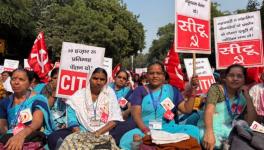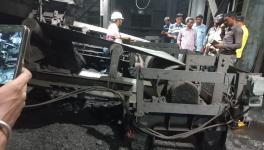Workers vs Volvo: Wheeling in Industrial Dispute
Far from Haryana, where industrial unrest at the Maruti Suzuki factory has been in the limelight, is an ongoing protest at the factory of another automobile giant.
Largely unreported by mainstream media, the workers at the only factory of the Swedish bus manufacturing firm Volvo, have struck work for around 60 days now (starting August 2). So for 60 days, every regular employee of Volvo has been protesting outside the factory premises against the oppressive management practices adopted by the company.
Located just 30 kilometres from Bangalore, the strike proceeds even as the management continues to push forward production using a combination of less experienced trainees, probationers and other assorted contract workers hired from staffing agencies. Needless to say, the quantity of production has been strongly impacted and the clients that placed orders with Volvo would need to be doubly concerned about the quality of buses delivered during this period of time.
One would imagine that companies that manufacture for and cater to the luxury segment of a product would manage to find enough margins to look after its workers well (each Volvo bus is sold between Rs 70 lakh to Rs 1.2 crore). Clearly, we are expecting too much here. It must be pointed out that it is the continued exploitation of the workers in this prestigious firm that initially led them to form a Union to get their voice heard.
The genesis of the conflict lies in the low wages at the factory, right from the time the Volvo buses division was set up in 2001. The share of Azad Builders, who had a 30 per cent minority stake in Volvo India, was bought out by Volvo in 2008, making it a fully-owned subsidiary of the Swedish giant. At this point of time, workers were being paid monthly wage of Rs 5,500. After continuous demands from the workers for higher wages – the management consented to give a salary hike of a measly Rs 650 in July 2009. When the workers asked for a higher wage uptick, the management of Volvo insisted that they would only negotiate with a recognised union. This requirement led to the creation of the Volvo Bus Workers Union (VBWU) and was registered in October 2009. The VBWU presented its official charter of demands to the management in January 2010.
Spark of mis-management
The management then entered into negotiations with the elected heads of the union on Friday, April 23, 2010. The negotiations went on for a long time and came to a conclusion only at 17:30 hrs on that day. Since the negotiations were to result in the long anticipated wage increases, there was a lot of curiosity among a section of the workers who waited near the meeting room to know what had happened. It was precisely between the conclusion of the meeting and the usual bus-departure time of 17:40 hrs, that Raghuram who was a manager in the administration asked the buses to leave at 17:35 hrs, five minutes before their usual time. Some other workers who were peacefully sitting in the bus, disembarked to protest this decision to send the buses early. The buses were sent out all the same. Being 10 kilometres from nearest town, Hoskote, these buses are the workers sole mode of transport after work.
This incident lies at the crux of the workers' misgivings. All the workers whom I spoke to, attested to this incident and said that they were victimised for no reason at all. This incident and the ensuing chain of events is a perfect case study in total mis-management.
Upon discovering that the buses had already left, all the workers then went to the management asking for the buses to be recalled, but the management refused. It is during this argument that there was a surge in the crowd which resulted in some people being pushed – both among the workers and the management. This was given a negative spin in the subsequent public relations campaign by Volvo as an assault by the workers on a foreigner, Mr Schwartz. The workers surrounded the management asking for transportation and this brouhaha went on till the early hours of the next day which was a Saturday, a holiday. On the same day the management suspended the representatives of the Union and two others. With no progress in sight, in August 2010, the workers went on a full-strike demanding the required wage hike that had never materialised and the reinstatement of their union representatives.
Harassment of workers
The strike led to tripartite negotiations and successfully ended with the long awaited wage settlement (valid for three years) with salaries increasing in the range of Rs 3,500-5,000 for the employees. However the workers, to their dismay, started to find themselves being increasingly harassed on the factory floor. All the probation periods were increased by one year, the managers started accusing employees of product sabotage and dragging them to the police, trainees were not regularised and there was an increase in the number of contract workers used (who are paid around half the salary of a regular employee). Apart from this, the management started to resort to other petty actions like denying workers any kind of leaves (whether for exams or personal problems), reducing the quality of transportation (without changing the salary contribution under the transportation head), harassment about breaks and so on.
What should be noted is that the three managers who were involved in the incidents of April 23, have since been moved out of the company or the division. Despite discovering errors on the side of the management during their domestic enquiries, the management did not reinstate the union representatives. While publicly taking a stand supporting dialogue with unions, Volvo internally kept its elected union members under suspension for over a year. With no other legitimate representation and facing increased harassment at the workplace, the workers saw no other option but to go on strike again on August 2, 2011. Their demands were primarily to reinstate the elected representatives of the union and against the harassment of probationers/trainees and regular employees. Subsequently, the union representatives were dismissed and now the strike soldiers on into its 55th day (as on September 25, 2011).
The larger picture
There are some external considerations that need to be factored in to understand the strike in the right perspective.
One: There has been double-digit inflation in the Indian economy since 2008 and it is through this period that automotive companies have refused to raise wages while trying to increase productivity. Their 'innovative' solution to compensate for rising input costs and market volatility was to increase the pressure on the workers. This not only depicts a profound lack of creative problem solving but has also led to increased industrial disputes from the north (1) to the south (2) of the country in 2011. The clinching aspect is that most of the unrest is limited to the automotive sector which has recently been facing various other market-related problems. It then becomes obvious that the market problems are being transmitted onto the ordinary employees thus reflecting the incompetency of the management.
Two: The Karnataka Government has been very closely linked with and is a prized client of Volvo. It recently purchased around 250 Volvo buses as part of the urban renewal scheme – JNNURM. Volvo found its name mentioned in a corruption accusation involving a trip by the Karnataka Transport Minister R Ashok to Sweden where Volvo is head-quartered (3). This was promptly denied by both the Minister and Volvo. The concerned Transport Department later retracted and apologised stating that it had provided wrong information in its RTI reply (4). The Government, in its zeal to boost industry, has also been a prime facilitator in the acquisition of the Volvo factory's land while being a leading purchaser of Volvo buses. This puts the Government in an uncomfortable conflict of interest when workers are exploited in the very same factory and it is the arbitrator in the dispute.
Three: There has been an increasing usage and exploitation of contract workers by Indian companies. The reaction of firms to local competition and globalisation has been the creative use (and abuse) of contractors and contract workers. The frustration against these rampant practices was recently shown in a trite Supreme Court judgement admonishing a private company for taking advantage of contract workers and summarily dismissing its petition. (5). Labour reforms, while simplifying the laws, should ensure that the workers are protected and allows them to work in a decent work environment. Those in policy-making capacities must keep in mind that Western free-market type relaxed labour practices, were implemented only after enforcing rigorous social security mechanisms and stringent health and safety laws – none of which exist in India.
Conclusion
It is the inability of the managements across India to maturely handle the market and workers that reflects in the high number of industrial disputes across the country. Harassing the workers and increasing their work-loads to intolerable levels is not a solution to market problems. This is understood by the best companies that have survived over long periods of time. While harassing workers may give some short-term marginal benefits in the balance sheets - it will only ruin the enterprise, its image and its products in the longer run. As for the employees of Volvo, small but determined, their struggle for a decent livelihood moves onto another day.
The VBWU is affiliated to the national union Centre of Indian Trade Unions (CITU).
3.http://www.hindu.com/2011/04/20/stories/2011042059860100.htm
4.http://www.hindu.com/2011/04/29/stories/2011042965110600.htm
5. Bhilwara dugdh utpadak sahakari Ltd. Vs Vinod Kumar Sharma – Supreme Court Judgement dated September 1, 2011
Secki P Jose is pursuing MA in Globalisation and Labour, Tata Institute of Social Sciences, Mumbai
Get the latest reports & analysis with people's perspective on Protests, movements & deep analytical videos, discussions of the current affairs in your Telegram app. Subscribe to NewsClick's Telegram channel & get Real-Time updates on stories, as they get published on our website.
























